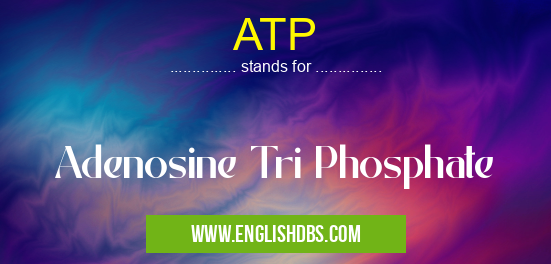What does ATP mean in UNCLASSIFIED
Adenosine Triphosphate (ATP) is the energy currency of life. It is an essential molecule used by all living organisms to power their metabolic reactions and biological processes. Every cell in the body requires ATP for growth, development, and maintenance of its structure.

ATP meaning in Unclassified in Miscellaneous
ATP mostly used in an acronym Unclassified in Category Miscellaneous that means Adenosine Tri Phosphate
Shorthand: ATP,
Full Form: Adenosine Tri Phosphate
For more information of "Adenosine Tri Phosphate", see the section below.
What Is ATP?
ATP is a nucleoside triphosphate consisting of adenine attached to ribose, with three phosphate groups bound at the 5' position. It is one of the most important molecules in biology as it serves as the main energy source for cells by storing energy in its chemical bonds which it releases when needed. The first phosphate bond contains a high amount of energy, while each subsequent bond contains less and less energy until finally releasing its usable form of adenosine diphosphate (ADP). When ADP is combined with another phosphate group, it can then be recombined into ATP. This allows for cells to regenerate new ATP molecules for use in further reactions that require cellular energy or movement within a cell.
Function Of ATP
ATP stores and transports chemical energy within cells for metabolism. It powers cellular activities such as muscle contraction, nerve impulse transmission, membrane transport and biochemical synthesis like DNA replication and protein production — all essential processes required for any organism to survive and thrive. Additionally, ATP also serves other regulatory functions in cells such as signaling pathways between molecules or tissues on a larger scale.
Essential Questions and Answers on Adenosine Tri Phosphate in "MISCELLANEOUS»UNFILED"
What is ATP?
Adenosine Triphosphate (ATP) is the energy currency of life and is found in all living organisms. It's a molecule that stores energy to be used for a wide range of biochemical processes.
Where is ATP found?
ATP molecules are found in all living organisms and are the primary source of energy for most cellular functions.
How does ATP store energy?
ATP stores energy through its three phosphate bonds, which can be broken and formed to release and take up energy, respectively.
What role does ATP play in metabolism?
ATP plays an important role in metabolism, as it powers metabolic pathways by providing energy for building molecules or breaking them down for energy production.
What happens when the body uses up stored ATP?
When stored ATP is used up by the body, it must create more from other sources of fuel such as fat, protein, or carbohydrates. This process is known as oxidative phosphorylation.
Is there any other way to generate ATP besides oxidative phosphorylation?
Yes! The body can also generate ATP with a process called glycolysis, which breaks down glucose into pyruvate molecules with some net gain of ATP.
How much energy does each molecule of ATP produce?
Each molecule of ATP produces about 7.3 kilocalories (kcal) of chemical energy when it's hydrolyzed back into ADP and phosphate ions.
Are there any health benefits associated with increased levels of ATP?
Increasing your levels of cellular-level ATP may promote better fitness performance over time, since having more available cellular fuel can help you exercise more efficiently and effectively. Additionally, research suggests that higher levels of free intracellular calcium may help optimize the generation and use of ATP within cells.
Final Words:
In summary, ATP is an important molecule found in every living organism that powers bodily functions without fail—it truly could be called “the currency of lifeâ€! Without it, there would be no metabolism or movement; nothing would function properly inside any given cell making them incapable of survival or growth.
ATP also stands for: |
|
| All stands for ATP |
